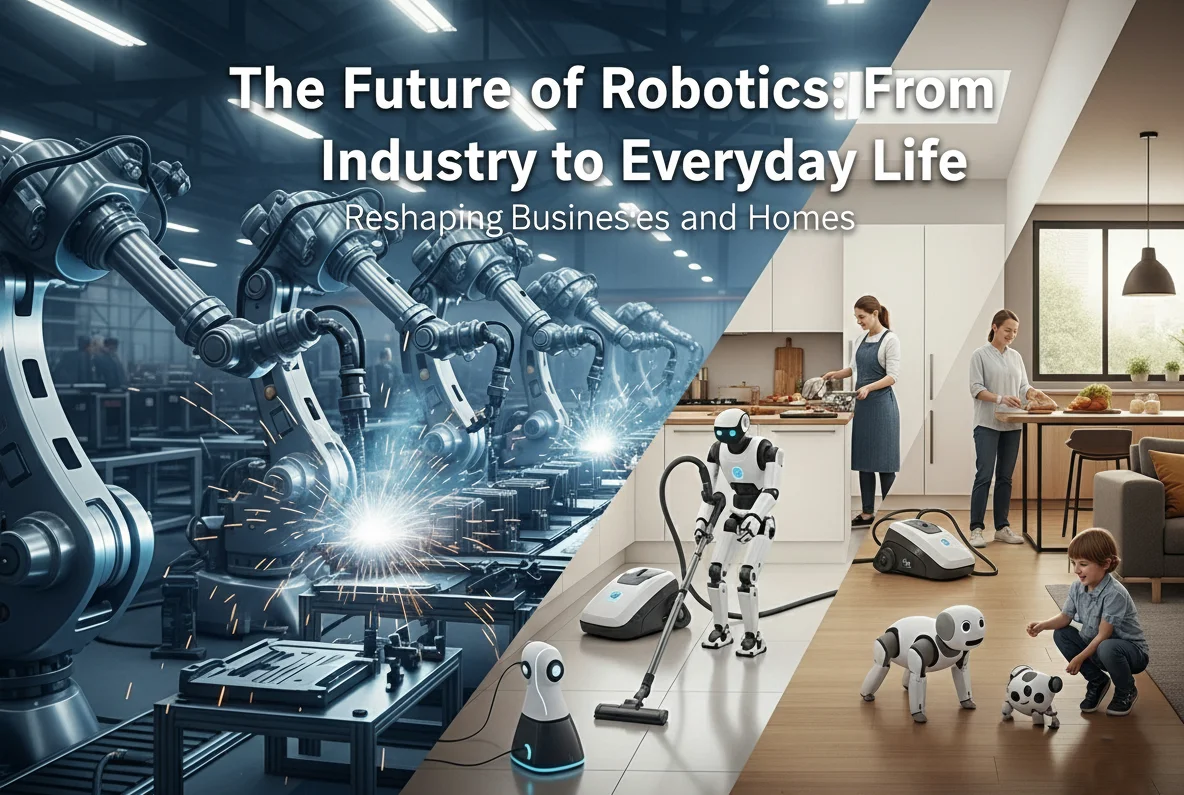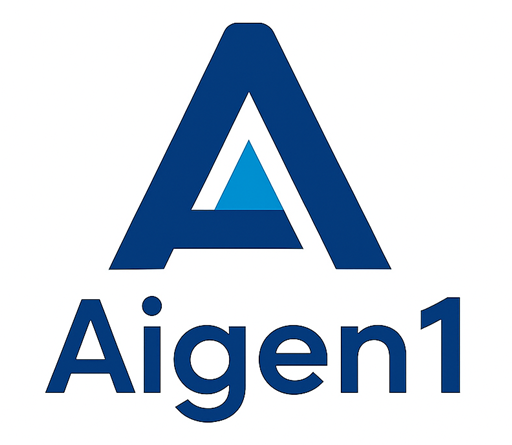Table of Contents
Introduction
The future of robotics is no longer just a subject of science fiction—it is a reality unfolding all around us. From factory floors to hospital rooms and even inside our homes, robots are becoming a vital part of our daily lives. Once limited to heavy-duty industrial tasks, modern robotics now extend to healthcare, education, agriculture, customer service, and personal assistance.
As technology continues to advance, robotics is combining with artificial intelligence (AI), machine learning, and automation to reshape industries and society. In this article, we will delve into how robotics is evolving, its role across various fields, and what the future holds for businesses and individuals. For more on how technology trends are driving business growth, check out our Top Tech & Software Trends for Business Growth.

The Evolution of Robotics
Robotics has advanced significantly since the first industrial robots were introduced in the 1960s. These early machines were designed primarily for repetitive and dangerous tasks on assembly lines. Over time, robots have become more sophisticated, integrating sensors, AI, and machine learning to make them smarter and more adaptive.
Today, robots are no longer limited to industrial automation. They can:
- Navigate complex environments.
- Assist doctors in surgeries.
- Provide companionship to the elderly.
- Perform household chores.
This evolution shows that the future of robotics lies not only in productivity but also in enhancing the quality of human life.
Robotics in Industry: The Backbone of Automation
In the industrial sector, robots continue to be game changers. With the rise of Industry 4.0, factories are adopting robots for:
- Assembly and packaging.
- Quality control and inspection.
- Hazardous material handling.
- 24/7 production without fatigue.
Research indicates that industrial robots boost efficiency by minimizing human error, reducing costs, and enhancing safety in hazardous settings. For example, robotic arms in car factories can now weld, paint, and assemble vehicles with unparalleled precision. Looking ahead, collaborative robots (cobots) will work side by side with humans, boosting productivity while ensuring safety. To learn more about cobots, visit Universal Robots, a leading manufacturer in the field.
Robotics in Healthcare: Precision and Care
Healthcare is one of the most promising fields for the future development of robotics. Robots are already assisting in:
- Robotic-assisted surgeries, enabling doctors to operate with an extreme level of precision.
- Patient care: Robots help transport medical supplies, monitor patients, and assist nurses.
- Rehabilitation: Exoskeleton robots support patients in regaining mobility after accidents or strokes.
In the future, we may see AI-driven robots diagnosing illnesses, delivering personalized treatment plans, and even offering emotional support to patients.
Robotics in Everyday Life: Smarter Homes
Robots are no longer limited to industries—they are entering our homes and daily routines. Examples include:
- Cleaning robots like robotic vacuum cleaners and mops.
- Personal assistants such as AI-driven robots that manage schedules, reminders, and household tasks.
- Educational robots that help children learn programming, problem-solving, and STEM concepts.
- Companion robots that provide emotional support for the elderly and people living alone.
With advancements in natural language processing and AI, these everyday robots are becoming more intuitive and human-like in their interactions.
Robotics in Agriculture: Sustainable Farming
Agriculture is also being transformed by robotics. Farmers now use drones and robotic machinery to:
- Monitor crop health.
- Automate planting and harvesting.
- Reduce pesticide use with precision spraying.
- Improve yield prediction through data analysis.
The future of robotics in agriculture could mean more sustainable farming practices, less manual labor, and increased food security for growing populations.
Robotics in Transportation and Logistics: Efficient Delivery
The logistics industry is rapidly adopting robotics to handle the increasing demand for fast delivery. Companies like Amazon use robotic systems in warehouses to:
- Sort and move products.
- Track inventory.
- Speed up packaging and dispatch.
Autonomous vehicles and delivery robots are also part of the transportation revolution. Self-driving trucks may soon transport goods across long distances, reducing costs and improving efficiency.
Challenges in Advancing Robotics
While robotics holds incredible potential, it also comes with challenges:
- Job displacement: Automation could replace certain manual jobs, requiring workers to reskill.
- High costs: Advanced robotics technology is expensive to develop and maintain.
- Ethical concerns: Robots making decisions raise questions about accountability and ethics.
- Cybersecurity risks: Connected robots can be vulnerable to hacking and misuse.
Addressing these challenges will be key to ensuring that robotics benefits everyone.
The Role of Artificial Intelligence in Robotics
Artificial intelligence is the brain behind modern robotics. AI enables robots to:
- Learn from experience.
- Recognize speech and images.
- Adapt to new tasks without constant programming.
For example, AI-powered robots can identify objects, respond to voice commands, and even predict human needs. The integration of AI with robotics is what makes the future of robotics so exciting, as machines become capable of performing tasks once thought impossible.
Future Outlook: Robotics by 2030
By 2030, robotics will likely be an inseparable part of our lives. Some predictions include:
- Smart cities with robotic infrastructure for waste management, security, and transportation.
- Home robots that cook, clean, and provide personalized care.
- Advanced medical robots capable of remote surgeries through telemedicine.
- Service robots in retail, hospitality, and customer support.
- Space robotics for exploration and building infrastructure on other planets.
The future of robotics promises a world where humans and robots coexist, complementing each other to achieve greater efficiency, safety, and quality of life.
Key Problem to Address
The rapid adoption of robotics raises concerns about workforce displacement. As automation replaces manual jobs, businesses must invest in reskilling programs to prepare workers for roles in robotics maintenance, AI development, and other emerging fields. This ensures a balance between technological advancement and economic stability.
Frequently Asked Questions (FAQ)
- 1. Will robots replace human jobs?
- Robots may replace some repetitive or dangerous jobs, but they will also create new opportunities in robotics engineering, AI, and technology management.
- 2. How are robots used in daily life?
- Robots are used for cleaning, personal assistance, education, entertainment, and even elderly care in modern households.
- 3. What industries benefit the most from robotics?
- Industries like manufacturing, healthcare, logistics, agriculture, and retail are seeing the biggest impact from robotics.
- 4. How does AI function within robotics?
- AI, or artificial intelligence, serves as the “brain” of robotics, enabling robots to learn from their surroundings and make decisions without human control. By integrating AI, robots can perform more complex tasks and adapt to changing environments, moving beyond simple, repetitive actions.
- 5. How will robotics transform our future, specifically in 2025 and beyond?
- By 2025 and beyond, robots will likely become more integrated into our daily lives, moving beyond simple tools and acting as common assistants in homes, cities, and workplaces. This increased presence will make everyday life more convenient and efficient.


